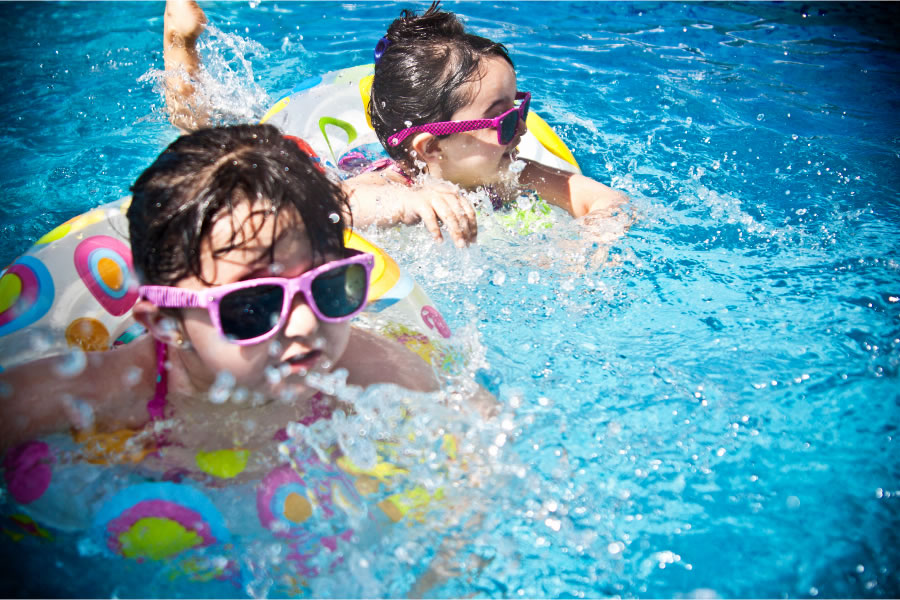
It's June, and school is out for summer! We've prepared a Summer Safety Tips Guide with ideas on the best ways to keep your kids safe and healthy. Kids everywhere are ready for the sunny days of summer.
Do you have lots of fun things planned? Our list includes picnics at the beach, swimming with friends in our backyard pool, and maybe even Stand Up Paddle Boarding!
Summer Safety Tips
Along with fun in the sun, summer can also bring increased exposure to all kinds of hazards, especially for children.
Falls, sunburns, insect bites, swimming accidents, pool-born pathogens, poison ivy and other rashes - there are many ways a child can get hurt when we least expect it!
Keeping Kids Safe
Fortunately, there are many things we as parents can do to keep our kids safe.The best way is to know the dangers and take steps to avoid them.
We've put together a few suggestions for keeping your kids safe and healthy. Use our guide to summer safety tips to make sure your kids keep safe all summer long.

Avoid Summer Sunburns
The warm sunny days of summer provide us with a real dilemma. We want our kids to play outside - doing the fun activities we remember fondly. Swimming, skate-boarding, games in the park, beach days - all these activities provide our kids with the healthy exercise and socializing with friends we want them to enjoy.
However, we also know that time in the sun can burn sensitive skin. This means short-term pain and possibly future problems like skin cancer. Just a handful of burns in childhood can increase the chances of skin cancer in adulthood. That's why it's important to protect our children's delicate skin from harmful rays. Here are a few key tips:
- Doctors recommend avoiding sunscreen and the sun for children under 6 months. If you must be outside, use protective barriers such as long sleeves, hats, and sunglasses for protection.
- Seek Shade. Avoid being outside during mid-day, when the sun's UV rays are strongest. And remember that the sun's rays are harmful and can burn even when skies are cloudy.
- Consider using natural sunscreens.Many dermatologists recommend natural sunscreens such as titanium oxide and zinc oxide for sensitive skin. These minerals act as a barrier, rather than using a chemical approach to sun protection. You may prefer to use these natural sunscreens for your kids, especially those with sensitive skin.
- Use SPF 15 or higher for children 6 months and older. Make sure your sunscreen has a UPF of 15 or higher and contains both UVB and UVA protection. Continue to use protective clothing, hats, and sunglasses to provide as much protection as possible.
- Lotion is the best protection. Sprays must be applied extremely close to the skin to be effective. Roll-ons must be applied 4 times to achieve effective coverage. And remember to apply lotion liberally, covering all exposed areas. Apply sunscreen 30 minutes before sun exposure, and reapply every two hours, and after swimming.
- Expiration dates matter. Active ingredients deteriorate over time so it's important to check the dates and discard expired sunscreen.
Prevent Accidents
Two of the leading causes of injury and death for children younger than age 14 are falls and drowning. Some simple steps can prevent many, if not most, of these accidents.Fall Safety Tips
Falls: Each day more than 8,000 children are seen in emergency departments for injury due to a fall. Falls are the leading cause of non-fatal injury for children. Some falls are part of growing up. Imagine a baby just learning to walk– falling down and getting back up over and over is part of the process.
We wouldn't want to protect our children from every possible stumble. However, we do want to prevent injuries from falls, and there are many things we can do to prevent these types of injuries:
- Make sure playgrounds are safe, using the acronym S.A.F.E.: Provide Supervision, ensure Age-appropriate equipment, provide appropriate Fall surfaces, and maintain Equipment. Following these guidelines for public and home playgrounds from the Consumer Product Safety Commission should improve safety.
- Ensure a safe environment at home. We teach our kids about Stranger Danger and worry about them when they're out of sight, but many injuries occur at home. These injuries could be prevented through the use of safety latches and screens on windows, guards at the top and bottom of stairs, non-skid pads for rugs, and other simple measures. The website Kids Health is a great resource for all kinds of information, and has excellent checklists you can use to ensure you are providing a safe environment for kids of all ages.

Bike Safety Tips
Practice bike safety, wear a helmet, and insist your kids wear helmets.Studies have shown that wearing a helmet reduces the risk of head and brain injury by more than 50%. And the vast majority of riders killed in accidents were not wearing a helmet. There is no federal law requiring bike riders of any age to wear helmets, but many states and local communities do have laws regarding bike helmets.
I insist that my children wear a helmet when riding (and I wear one myself) regardless of the law, but if you'd like to know what your local law says, you can review detailed listing of where helmets are required. Other ways to improve bike safety include:
- Wear appropriate clothing that won't get caught in the chain.
- Check your brakes to be sure they work well and aren't sticking.
- Make sure your seat, handlebars, and wheels fit tightly.
- Make sure your bike and clothing have reflective patches and colors that stand out so motorists can see you.
Kids and Concussions
We used to think a bump on the head was no big deal. Studies show, however, that concussions are serious business and even mild ones should not be taken lightly. Make sure to check with your doctor after any head injury, and especially if there are symptoms such as:- Dizziness
- Double or blurry vision
- Confusion
- Nausea or vomiting
- Mood changes
- Changes in behavior
Water Safety Tips
When it comes to summer safety tips for kids, we have to talk about water. Drowning is the leading injury-related cause of death for children 1-4 years old and the second leading cause of death for children 1-14 years old. Young children can drown in less than two inches of water. Nearly 75% of all drownings of children under 14 occur at a residence– either the family's pool, or a friend or neighbor's pool.Two-thirds of injured children are boys.Water play is essential to most people's vision of a fun summer, but water and pool safety require following these simple but critical steps:Summer Safety at the Pool Means Never Losing Focus
1. Supervise.The only way to keep children completely safe around water is continuous supervision by an adult who can swim. Keep within grabbing distance.
2. Assign an adult water watcher.Make sure one adult who can swim is always responsible for watching for signs of trouble. This person should never be distracted by answering the phone, texting, or any other activity.
3. Encourage swim lessons.Make sure everyone can swim from the youngest age possible.
4. Fence-in pools.Make sure pools, spas, and hot tubs have secure fences which are four feet or higher. The Consumer Product Safety Commission has excellent information on how to ensure barriers are sufficient to prevent children from entering.
5. Install pool alarms.Seventy-seven percent of pool accident victims were missing for 5 minutes or less! Pool alarms provide an alert that the water surface has been broken, buying critical seconds once a child has fallen into the pool.
6. Require non-swimmers to wear life jackets.Non-swimmers should always wear life jackets when on or around the water.
7. Learn CPR for children.It's a good life skill that you never want to need, but will be glad you have if an emergency situation arises.
Secondary Drowning Prevention
More than one mom has had the unfortunate nightmare of learning first-hand what it means to experience secondary drowning.Visit the Delighted Momma blog to read her story. Thank you for being brave enough to tell your story, Lindsay. Now, we are all more aware!

Water Hygiene - Is This Pool Clean?
You may have seen the recent articles about bacteria and pathogens lurking in crystal clear swimming pools. It's true, you can't tell by looking whether a pool harbors harmful organisms that can cause rash or illness in your little ones.Clean Bodies Help Keep Pools Clean
Here are some guidelines to follow to help ensure you don't bring anything other than a sunburn back from the pool:- Don’t ever swallow pool water.
- Shower with soap and water before and after swimming.
- Wash hands with soap and water after using a toilet or changing diapers.
- Remove small children from pools for bathroom breaks and check diapers often.
- Change diapers in a bathroom, not beside the pool.
- Wash children, especially their rear ends, thoroughly with soap and water before they enter a pool.
- Don’t swim when you have diarrhea. Diarrhea can be transmitted in pool water weeks after symptoms cease.
Insects, Ticks, and Coyotes, Oh My!
Many areas of the U.S. have abundant mosquitoes and ticks. While mosquito-born diseases are more common in tropical climates, it's best to avoid their bites. The best protection is wearing long sleeves and long pants when out after dark, and a generous application of bug spray. You can find more information about mosquitoes and the different types of repellants here.Ticks and Disease
Tiny ticks have caused much suffering and in addition to Lyme Disease, there are reports of new tick-borne diseases to watch out for. Use these tips to avoid tick bites:
- Avoid grassy, brushy, or wooded areas, where ticks tend to be.
- Treat clothing with repellant. Use a type appropriate for your children's age. More information is available on the CDC website.
- Walk in the center of trails.
- Check clothing for ticks. Ticks can be killed by putting clothes in the dryer on high heat for 10 minutes. (Additional time may be needed if clothes are damp.)
- Shower within two hours of coming indoors.
- Do a careful tick check of your and your children's bodies after being outside.
- Check gear and pets for hitchhiking ticks.
Coyotes (and other wildlife)
The recent rise in coyotes has stunned people in my coastal town outside Boston. Many families have lost cherished pet cats, and last year, a coyote bit a teenager. With growing encroachment on wildlife habitat, we will continue to find more wild animals in our backyards. Here are some guidelines for living with these and other wild animals. For more information, check out the Urban Coyote Research website.- Do not run or turn your back.
- Be as big and loud as possible.
- Wave your arms and throw objects.
- Face the coyote and back away slowly.
- If attacked, fight back.
- Protect your pets - keep them on a short leash.
- Use extra caution dusk through dawn.
- Avoid known or potential den sites.
- Be prepared: Walk with a walking stick, carry a noise maker, walk with a buddy.
Rabies
While rabies is rare, it is also deadly. Rabies is spread through the saliva of an infected animal, so the key is to avoid being bitten by a rabid animal. There are a few simple rules to follow when rabies is a possibility:- Don't feed wild animals.
- Avoid and report any animal acting strangely - for example if it looks sick.
- Don't pet wild animals, or animals you don't know.
Follow These Summer Safety Tips
We all want our kids to have a safe and fun summer holiday. By keeping these simple rules in mind as you prepare for a summer vacation or simply hanging out at home, you can help to ensure that your kids remain injury-free throughout the carefree summer months!
By Liz Smith. Liz has worked across the globe for many of the world's best known apparel brands, including Justice, Chico's, Victoria's Secret, and Hanes. She has worked closely with dozens of factories in more than 20 countries to ensure that production is of the highest standard. Liz has managed all aspects of garment production, from design through fabric development to sewing and merchandising - so she knows what it takes to make high-quality apparel. Liz is thrilled to share her knowledge about clothes to help discerning customers choose the finest products.

